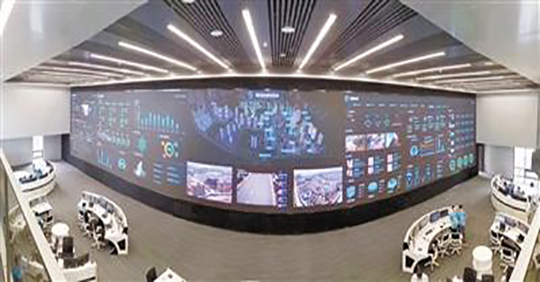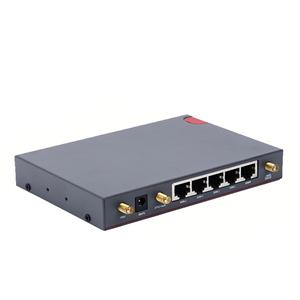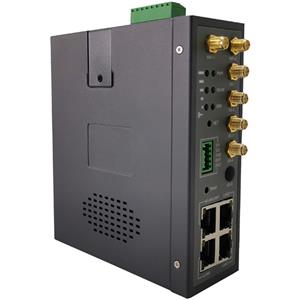NB-IOT wireless communication technology promotes wisdom perception
NB-IOT wireless communication technology promotes wisdom perception

The convenience of smart travel is often an important part of the "smartness" of smart cities. The shuttle bus realizes online ticket purchase and boarding automatic ticket checking, and the whole process is unmanned.
Today, the security model of "deep learning technology + electronic police" is being used in smart communities.
Roads that never accumulate water, trash cans that are always dissatisfied, properties that appear immediately when needed, imperceptible and ubiquitous services ... The urban scenes we see in science fiction movies are gradually emerging in life . With the application of 5G, AI, big data, and the Internet of Things, more and more enterprises are participating in the intelligent upgrade of the layout space, that is, the smart city. 5G is officially commercialized in 2019, and the design of smart cities, from the bottom to the top, will produce better solutions. Under the new stimulus, the development and application of smart cities are more mature, and there are more and more projects to join the smart community transformation. Recently, a number of housing companies have released smart community plans. Communities equipped with "brains" can not only achieve various service functions, but also be good at learning and thinking, and the "IQ" of problem solving is constantly improving.
The new generation of information technology represented by cloud computing, the Internet of Things, artificial intelligence, etc. is changing traditional industries and changing the cities in which we live. The Internet of Things (IoT) is an important part of the new generation of information technology. It is widely used in the convergence of networks through communication perception technologies such as intelligent perception, identification technology and pervasive computing. The third wave of world information industry development after the Internet. At present, the application scenarios of the Internet of Things are distributed in smart cities, smart homes, smart security, smart transportation (Internet of Vehicles), smart agriculture, smart healthcare, smart grid, smart retail, and smart logistics.
In order to protect the environment of the town, a smart trash bin is deployed in the town to monitor the garbage capacity in the trash bin in real time. Once the warning value is exceeded, the garbage compression function is activated, and the cleaning staff is alerted to clean up the garbage in time.
Self-driving cars, face recognition, drone patrols, automatic drip irrigation ... when these highly technological products and equipment come together, what kind of life will they bring? Positioned as a world-class IoT industry platform, the first batch of provincial-level special towns announced by the Guangdong Provincial Development and Reform Commission, Laohu Science and Technology Town, has a total planned area of 8 square kilometers. It has officially opened in September 2018 and will end in 2019. More than 1,000 people work and live inside the town. According to Xiang Junbo, assistant president of Country Garden Group and general manager of the Production City Development Division, the current IoT platform for the Pohu Lake Technology Town has been completed. As of November 2019, the Pohu Lake Smart Town facial recognition placement system, A total of 8 visitor reservation management platforms, face recognition access control systems, online ticketing and riding systems, park shuttle bus systems, smart parking lot management systems, industrial customer registration systems, and VIP visitor arrival reminder systems have obtained innovative application software copyright certificates.
By deploying drones, fixed-point regular air patrols on main roads and key borders, instead of traditional manual patrols, not only improve patrol efficiency, but also quickly alert processing; deploy dual video surveillance systems through cameras, including aerial 360 ° panoramic video Surveillance system and HD video surveillance system with no dead corners in the ground / building ... Such a scene is not a bridge in a movie, but a basic "skill" possessed by a smart town. The first phase of the technology town that has been opened has a total of 50 subsystems and nearly 20,000 point sensing layouts, and all intelligent equipment is fully monitored. Every system and point is the landing and application of the Internet of Things.
The two monitoring systems in the air and the ground complement each other, not only can monitor all roads, building façades, green platforms, public areas and other outdoor areas and three-dimensional vertical spaces, but can also monitor personnel residence areas, buildings that cover areas such as life and work. All outdoor and indoor areas in the building, parking lot, elevator hall, etc., together ensure full coverage of the town's 3D video surveillance and maintenance.
In addition, face recognition technology is also standard, and self-access for small town residents through face recognition access control. In cooperation with the leading companies in the industry for deep learning algorithms for faces, the town's face recognition access control system uses dynamic and non-cooperative methods for verification, creating a precedent for unattended watchkeeping.
Strangers who do not report in advance stay in the community for more than a certain period of time, or do not follow the prescribed trajectory, the system automatically informs the property; children playing in the community, approaching a dangerous area will report the alarm; the elderly will notify the family and Property; people can be found automatically based on videos and images ... How can these very practical functions be realized? According to Huang Xixiong, co-founder and general manager of the Gizwits IoT development platform, the IoT can realize the perception and recognition control of things, and networked interconnection and intelligent processing can be organically unified to form highly intelligent decisions. The industrial architecture for the development of the Internet of Things is mainly divided into four layers, namely the perception layer, the transmission layer, the platform layer, and the application layer.
First of all, there must be a widespread perception network system distributed throughout society. Such as manhole covers and street lights, all terminal equipment can be online and data can be uploaded in real time. This means that the "skins" of cities and communities are covered with sensors, and no matter which corner of the "body" is "itch" or "pain", the "brain" can receive signals. The second is the operation management center and big data center, which is equivalent to the brain and center of a city or community. Massive data requires supercomputing capabilities, artificial intelligence assists in processing information, and 5G can improve the efficiency of information transmission. The third is the application of data. Through differentiation and big data analysis, processing instructions are issued. For example, the manhole cover and street lights are broken, which departments should cooperate with them to deal with it.
At present, housing companies such as Country Garden, China Resources Land, Longhu, Vanke, and Shimao have deployed smart city development and construction. At the 2019 World Artificial Intelligence Conference, Vanke announced its cooperation with Microsoft to co-sponsor the establishment of the Vanke Future City Lab with the theme of "future cities". Longhu's community in Chongqing has been able to provide services for 64 scenarios and is expanding into the field of urban operation and management. China Resources Land has also set up an IoT laboratory and developed its own Ruiyun system.
According to Xiang Junbo, the current Internet of Things platform in the Pohu Lake Technology Town has been completed. The visualization system of the smart city control center is equivalent to the smart brain of the town. All the background systems of the entire town are uniformly deployed on the cloud data center private cloud. The visual management center implements a visual and graphical display of the town's various business operation data and equipment and facility management data through the town's big data analysis system for the town administrators to quickly analyze and make decisions. Based on the four platforms of the IoT IoT platform, industrial operation service platform, aggregate payment platform, and big data analysis platform, the digital and precise management of settled enterprises, enterprise employees, owners, visitors, vehicles, equipment and facilities, park management, transactions, etc. .
A few days ago, Shimao joined hands with Alibaba Cloud, voice intelligence technology manufacturer Yunzhisheng, and face recognition system company Shangtang Technology to release the news that the AI smart community will be launched in Guangzhou. New projects in Haizhu and Yuexiu will be realized. Enjoy a comfortable life. “Turn on the air conditioner” and “Higher temperature”, no hands-on, easy and intelligent voice control of all home devices, “Scenario lighting, entertainment relaxation, payment warranty, emotional chat, air assistant, indoor security and other 300+ skills, can achieve moving mouth A hands-free smart life experience. With Alibaba Cloud's "cloud platform" and "super brain", the house will also automatically iterate and upgrade, not behind the times due to technology and equipment updates.
At present, various new energy equipment is used in various public facilities in buildings and living quarters, and many buildings can solve their own energy problems. For example, rooftop photovoltaic, solar photovoltaic, photovoltaic pavement, wind power, breeze power generation, science and technology town, and the first domestic copper indium gallium selenium thin film photovoltaic building integration project in strategic cooperation with National Energy Group.
Starting from the efficiency of municipal environmental management, communities equipped with "brains" use intelligent methods to automate management and maintenance for air, water quality, green irrigation, road safety, environmental sanitation, waterlogging, and lighting, which improves operational efficiency and reduces Human and resource costs. The town weather station can monitor wind direction, wind speed, temperature, humidity, pressure, and rainfall at the same time. At the same time, the weather station can perform real-time weather forecasting, and the weather conditions are pushed to town enterprises and personnel in real time through the NB-IOT network, so as to plan ahead.
The NB-IOT manhole cover and water level sensor deployed on the main road are also "smart" intelligent assistants, which can monitor the status of the manhole cover in real time. When the manhole cover is broken, stolen, or other abnormalities occur, the management staff is alerted in time, and video monitoring System linkage to quickly locate and resolve police situations. In view of the fact that the science and technology town is located in the Pohu Lake Wetland, the town planning has incorporated waterlogging prevention into the construction plan. The town has deployed NB-IOT water level flood sensors in the main drainage pipes, underground parking lots, data centers, and computer rooms to detect real-time waterlogging conditions 24 hours a day. Once the waterlogging occurs, the linkage drainage system and the first time alarm.
In addition, materials and equipment such as soil detectors, intelligent weather stations, intelligent irrigators, and water pipe sprinklers are installed in the green area of the park. The soil detector regularly sends the water and fertilizer content data of plants in a certain area through the NB-IOT wireless communication technology and the Internet, and transmits it to the plant cloud platform database. The database is compared with the corresponding plant species data. If the water is insufficient, the platform will issue instructions To the intelligent watering device in the corresponding area, realize intelligent water supply. If the weather station reports the current rain condition, the system will automatically turn off the irrigation to save water.




